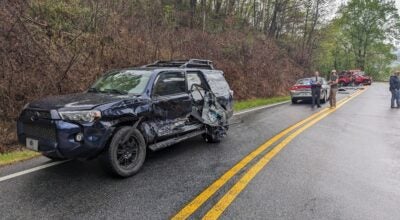Google makes Bulletin’s archives searchable online
Published 3:41 pm Friday, August 7, 2009
Google began offering old newspapers in full-text article searches in September 2008, and the&bsp;Bulletin&bsp;began hosting the&bsp;Tryon Daily Bulletin&bsp;Old Article Search, powered by Google, on its tryondailybulletin.com website a few weeks ago, according to publisher Jeff Byrd. Over 11,000 articles are searchable online.&dquo;Google has our microfilm copies of the entire extant catalogue of old issues, but not all are available online just yet,&dquo; Byrd said. &dquo;Additional batches are being added over time as Google processes the microfilm to live, searchable articles,&dquo; Byrd said. In the next year or two, almost the entire history of the&bsp;Bulletin&bsp;should be available to be searched by key words, he said. &dquo;Not only that, but once you reach an article you have searched for, you can browse through old issues exactly as they were printed,&dquo; Byrd said, &dquo;photographs, headlines, articles, advertisements and all.&dquo; Want to know how Seth Vining did in the Boy&squo;s Club Athletic Day competitions in July, 1938? Go to the Tryon Daily Bulletin Old Article Search box on the upper right side of the tryondailybulletin.com home page and type in &dquo;Seth Vining.&dquo; While you are reading through that four-page 1938 issue, check out the Curb Reporter&squo;s comments on the new ladies&squo; &dquo;tippy-tippy hats&dquo; just in at the Ballenger-Jackson Co. They wouldn&squo;t stay on without an elastic strap.&bsp; Flip a page and take a gander also at the ads for the Home Ice and Creamery Plant&squo;s new Conditionaire Ice Refrigerators. &dquo;It&squo;s the history of the Thermal Belt, now available at your computer,&dquo; Byrd said.&bsp;&uot;We&39;re proud to be partnering with the Tryon Daily Bulletin,&uot; said Laura Driussi, the Bulletin&39;s Strategic Partner Manager with Google News Archives.The&bsp;Bulletin&bsp;was fortunate in two instances to be able to make the Tryon newspaper&squo;s archives so completely available and searchable, Byrd said. First, in the early 1990s, the N.C. State Library undertook a project to preserve the archives of the state&squo;s newspapers. &dquo;The old issues of the&bsp;Bulletin&bsp;were stacked in the basement of the&bsp;Bulletin&bsp;building,&dquo; Byrd said, &dquo;They were in some disarray and a termite colony had even eaten its way up through one stack.&dquo; So, the&bsp;Bulletin&bsp;was a perfect candidate for the state library project. Student interns working on the project came to Tryon and began sorting through every old paper, cataloguing each issue, through each month and each year, to get as complete a set of old&bsp;Bulletins&bsp;as possible. &dquo;We even advertised the dates of missing issues, those we did not find here in the building, and readers brought us some of those,&dquo; Byrd said. &dquo;The result was that almost all of the history of the paper was saved on microfilm, except unfortunately for the first year of its publication. There were very few from 1928.&dquo; Copies of the complete set of&bsp;Bulletin&bsp;microfilm archives were kept at the state library in Raleigh and at the Polk County Library in Columbus. Local historians, however, still had to search issue by issue to find what they were looking for. Often, they did this by thumbing through the physical copies at the Bulletin office, often finding what they were looking for only after hours of looking, and typically in issues years before or after the years they had targeted in their research. &dquo;Clearly, in the digital age, we knew there was a better way, but the cost of converting 80 years of old newspapers to word searchable, digital files was beyond our means,&dquo; Byrd said. Then, along came the next fortuitous moment. Google called in 2007 with an offer to participate in the Google News Archive Search project. The&bsp;Bulletin&bsp;bought a set of the state archives microfilms, sent them to Google, and the rest is now fast becoming word-searchable history. &dquo;We&squo;re launching an initiative to make more old newspapers accessible and searchable online by partnering with newspaper publishers to digitize millions of pages of news archives,&dquo; Google said in its Google News Archives launch press release last fall. &dquo;In 2006, we started working with publications like the&bsp;New York Times&bsp;and the&bsp;Washington Post&bsp;to index existing digital archives and make them searchable via the Google News Archive. &dquo;Over time, as we scan more articles and our index grows, we&squo;ll also start blending these archives into our main search results so that when you search Google.com, you&squo;ll be searching the full text of these newspapers as well. &dquo;For more than 200 years, matters of local and national significance have been conveyed in newsprint ‐ from revolutions and politics to fashion to local weather or high school football scores,&dquo; Google said in its announcement. &dquo;As we work with more and more publishers, we&squo;ll move closer towards our goal of making those billions of pages of newsprint from around the world searchable, discoverable and accessible online.&dquo; &bsp;&bsp;&bsp;





